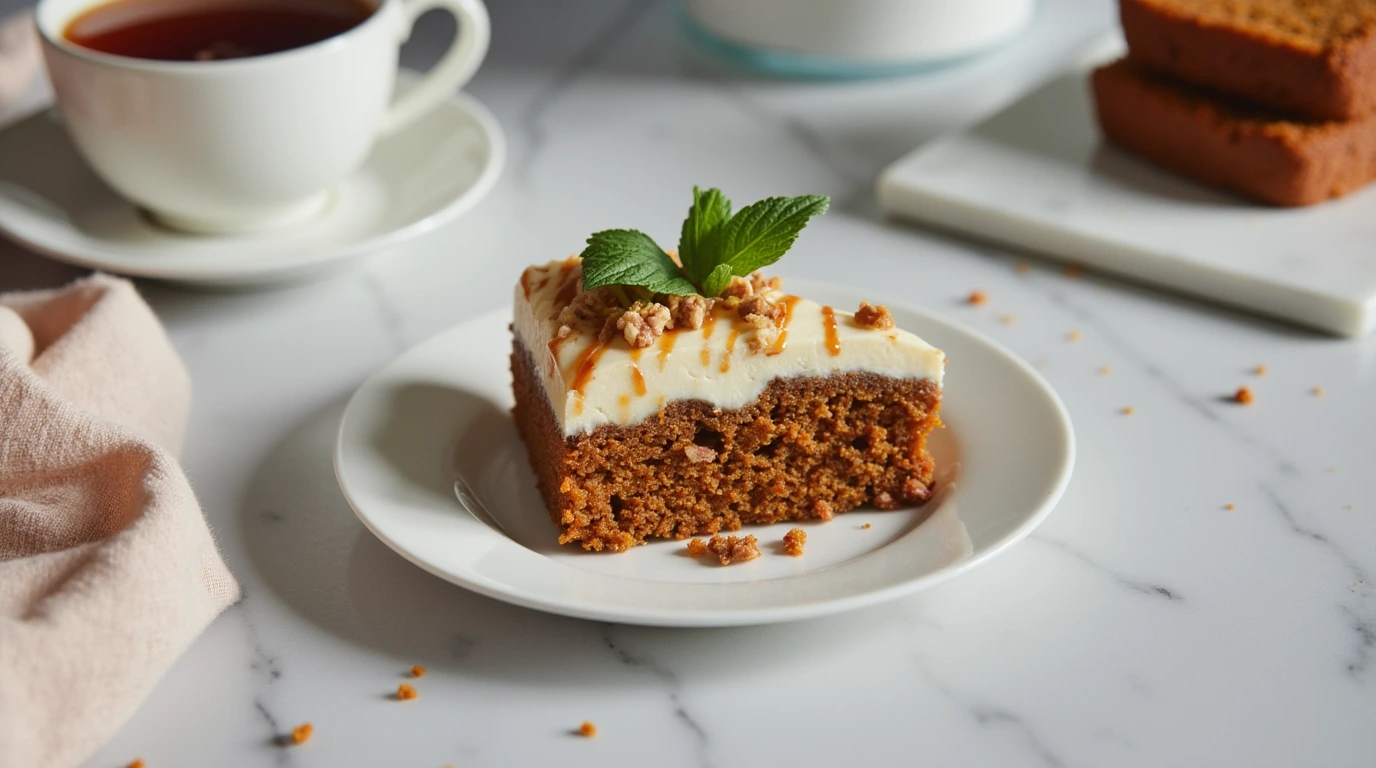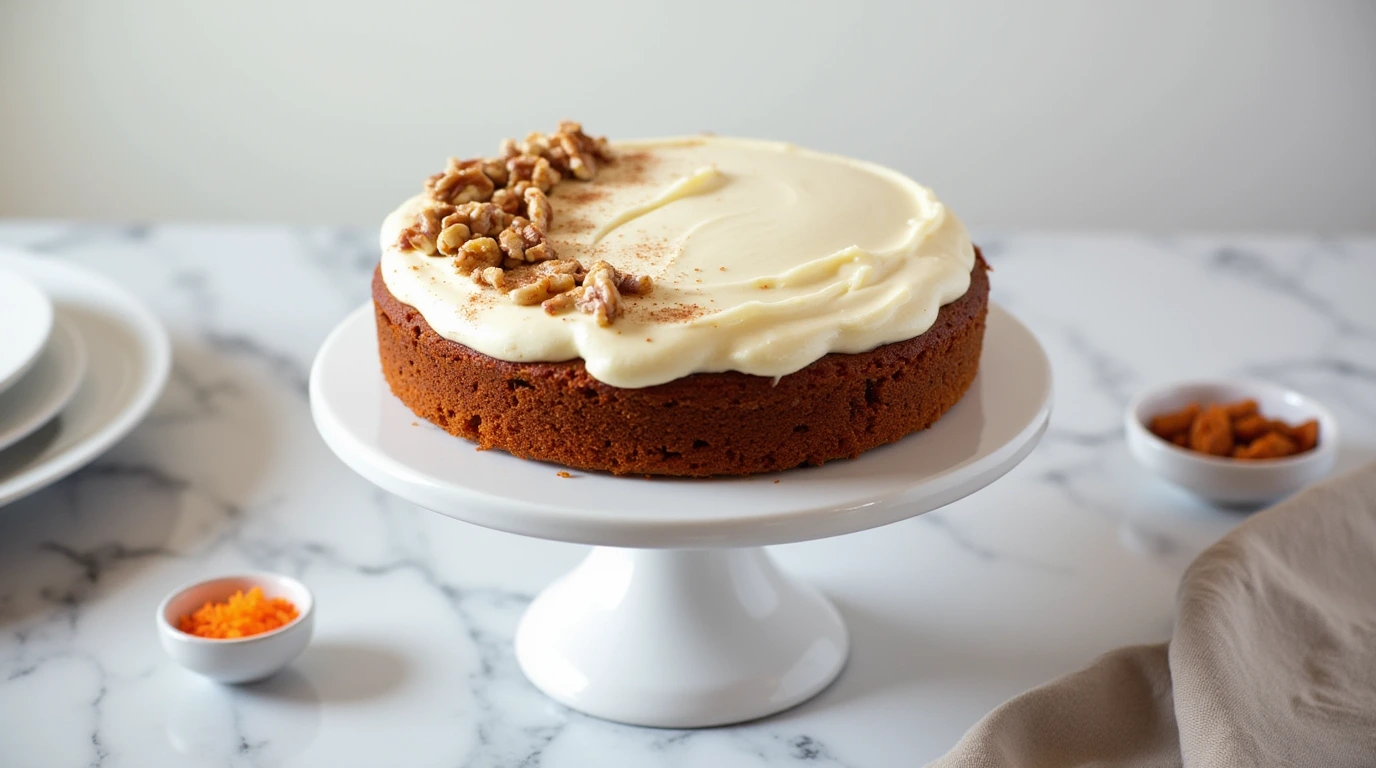Carrot cake is a dessert classic, loved for its moist texture, warm spices, and creamy frosting. Making it gluten free ensures everyone can enjoy this delicious treat, whether they follow a gluten free diet or simply love a healthier twist on traditional recipes. Packed with fresh carrots, wholesome ingredients, and just the right balance of sweetness, this recipe is perfect for birthdays, holidays, or a simple afternoon indulgence.
For more inspiration, explore healthy gluten free breakfast cake loaf for another delicious and easy-to-make gluten free dessert.
Why Gluten Free Carrot Cake is Special
The magic of this cake lies in its ability to combine indulgence with health-conscious ingredients. The moist texture comes from freshly grated carrots, while gluten free flour creates a tender crumb that rivals traditional recipes. Whether you’re catering to dietary needs or exploring new baking options, this cake is sure to impress.
If you’re looking for more ways to enjoy gluten free baking, try this recipe for gluten free pumpkin bread for a perfect seasonal companion.
Key Ingredients
To create the perfect gluten free carrot cake, you’ll need the following ingredients. Each one plays an important role in achieving the cake’s texture, flavor, and structure.
Ingredients List:
- Gluten Free Flour Blend: 1 ½ cups (180g) – Provides the structure for the cake. Ensure the blend includes xanthan gum or add ½ tsp if not included.
- Brown Sugar: ¾ cup (150g) – Adds sweetness and a slight molasses flavor for depth.
- Vegetable Oil or Sunflower Oil: ½ cup (120ml) – Keeps the cake moist and tender.
- Eggs: 3 large – Provides structure and helps the cake rise.
- Vanilla Extract: 1 tsp – Enhances the flavor of the spices and carrots.
- Carrots: 2 cups (200g), coarsely grated – Adds natural sweetness, moisture, and texture.
- Baking Powder: 1 tsp – Ensures the cake rises evenly.
- Baking Soda: ½ tsp – Helps with leavening and creates a light crumb.
- Salt: ½ tsp – Balances the sweetness and enhances the flavors.
- Ground Cinnamon: 1 ½ tsp – Adds warmth and spice.
- Ground Ginger: ½ tsp – Provides a slight zing to complement the sweetness.
- Ground Nutmeg: ¼ tsp – Adds depth and warmth to the flavor profile.
- Walnuts or Pecans (Optional): ½ cup (50g), chopped – Adds crunch and texture to the cake.
Optional Add-Ins:
- Raisins or Dried Cranberries: ½ cup (50g) – Adds a pop of natural sweetness.
- Orange Zest: 1 tsp – For a citrusy aroma and flavor twist.
Step-by-Step Instructions
With the ingredients perfectly measured, follow these steps to create a delicious gluten free carrot cake.
1. Preparation
- Preheat the oven: Set your oven to 350°F (180°C). Grease a 9-inch round or square cake pan and line it with parchment paper for easy removal.
- Prepare the carrots and nuts: Coarsely grate 2 cups (200g) of carrots and chop ½ cup (50g) of walnuts or pecans if using. Set aside.
2. Mix the Wet Ingredients
- In a large mixing bowl, whisk together:
- ¾ cup (150g) of brown sugar
- ½ cup (120ml) of vegetable or sunflower oil
- 3 large eggs
- 1 tsp of vanilla extract
- Whisk until the mixture is smooth and slightly frothy.
3. Combine the Dry Ingredients
- In a separate bowl, sift together:
- 1 ½ cups (180g) of gluten free flour blend
- 1 tsp baking powder
- ½ tsp baking soda
- ½ tsp salt
- 1 ½ tsp ground cinnamon
- ½ tsp ground ginger
- ¼ tsp ground nutmeg
- Mix well to ensure the spices and leavening agents are evenly distributed.
4. Combine Wet and Dry Ingredients
- Gradually add the dry ingredients into the wet ingredients, mixing until just combined. Avoid overmixing to ensure a light texture.
- Fold in the grated carrots and chopped walnuts (or your choice of optional add-ins like raisins or dried cranberries) until evenly distributed.
5. Bake the Cake
- Pour the batter into the prepared pan and smooth the top with a spatula.
- Bake in the preheated oven for 35–40 minutes, or until a toothpick inserted into the center comes out clean.
- Remove the cake from the oven and allow it to cool in the pan for 10 minutes. Transfer to a wire rack to cool completely before frosting.
6. Frost the Cake
- Once the cake is completely cooled, prepare the cream cheese frosting (see instructions above).
- Spread the frosting evenly over the top of the cake using an offset spatula. Garnish with chopped nuts or shredded coconut for added flair.
Cream Cheese Frosting

Ingredients:
- ¾ cup cream cheese (cold)
- ¾ cup heavy cream (cold)
- ⅔ cup powdered sugar (sifted)
- 1 tsp vanilla extract
Instructions:
- Whisk cream cheese until smooth.
- Add heavy cream, powdered sugar, and vanilla. Whip until soft peaks form.
- Spread frosting over the cooled cake and garnish with chopped nuts or shredded coconut.
Creative Variations
- Vegan Option: Replace eggs with flaxseed meal (1 tbsp flaxseed + 2.5 tbsp water per egg).
- Keto-Friendly Carrot Cake: Use almond flour and a low-carb sweetener like erythritol.
- Nut-Free Version: Omit nuts or replace them with sunflower seeds for crunch.
- Layered Carrot Cake: Slice the cooled cake into two layers and spread frosting between them.
- Dairy-Free Frosting: Swap cream cheese with coconut cream and powdered sugar for a light alternative.
Complement your baking repertoire with this almond flour chocolate cake, another decadent gluten free dessert option.
FAQs
1. Can I Make This Cake Nut-Free?
Absolutely! If you have a nut allergy or prefer a nut-free option, simply omit the nuts from the recipe. To maintain the texture and crunch that nuts provide, you can replace them with alternatives like:
- Sunflower Seeds: These are nut-free and add a similar crunch.
- Pumpkin Seeds: Great for texture and a subtle nutty flavor.
For more nut-free baking inspiration, check out this recipe for gluten free cornbread muffins, which is perfect as a savory treat.
2. Do I Need to Peel the Carrots?
Peeling carrots is optional but recommended. While the skin of carrots is edible, peeling ensures:
- A smoother batter without any tough bits.
- A sweeter and cleaner carrot flavor.
If you’re short on time, you can skip peeling if the carrots are thoroughly washed and free of dirt.
3. Why is My Cake Dense?
A dense cake can be disappointing, but here are some common reasons and fixes:
- Overmixing the Batter: Overmixing activates too much air, causing the cake to collapse during baking. Mix until the ingredients are just combined.
- Finely Grated Carrots: Finely grated carrots release too much moisture, leading to a dense texture. Stick to coarsely grated carrots to maintain the right balance of moisture.
- Incorrect Measurements: Using too much flour or too little leavening (baking powder/soda) can also cause density. Measure ingredients carefully using a scale for accuracy.
4. Can I Freeze Gluten Free Carrot Cake?
Yes, gluten free carrot cake freezes beautifully and is perfect for make-ahead desserts. Follow these steps:
- Slice: Cut the cake into individual portions for easy serving.
- Wrap: Wrap each piece tightly in plastic wrap to prevent freezer burn.
- Store: Place the wrapped slices in an airtight container or freezer bag.
The cake can be frozen for up to three months. When ready to eat, thaw slices at room temperature or warm them slightly in the microwave for a fresh-from-the-oven feel.
5. What Frosting Alternatives Work Well?
If cream cheese frosting isn’t your preference, here are some delicious alternatives:
- Powdered Sugar Glaze: Mix powdered sugar with a splash of lemon juice or milk for a simple, tangy glaze.
- Whipped Coconut Cream: Chill a can of coconut milk, scoop out the solid cream, and whip it with a little powdered sugar for a dairy-free option.
- Buttercream Frosting: For a richer option, make a vanilla or cinnamon buttercream.
- Greek Yogurt Topping: Sweeten plain Greek yogurt with honey or maple syrup for a healthier, tangy topping.
Experiment with these options to match your flavor preferences or dietary needs.
Storage and Tips
Proper storage is essential to maintain the freshness and flavor of your gluten free carrot cake. Here’s how to store it effectively and tips to make it last longer while retaining its moist texture and creamy frosting.
1. Room Temperature
- Duration: Store in an airtight container for up to 2 days.
- Best Practices:
- If the cake is unfrosted, it can safely sit at room temperature without drying out.
- For frosted cakes, ensure they are stored in a cool, dry place to prevent the frosting from softening. Avoid direct sunlight or heat exposure.
2. Refrigeration
- Duration: Keeps fresh in the refrigerator for 3–4 days.
- Best Practices:
- Place the cake in an airtight container to prevent it from absorbing other fridge odors.
- Let the cake sit at room temperature for about 15–20 minutes before serving to bring back its soft texture and enhance the flavor of the frosting.
3. Freezing
- Duration: Freeze individual slices for up to 3 months.
- Best Practices:
- Slice: Cut the cake into individual servings for easy thawing and portion control.
- Wrap: Wrap each slice tightly in plastic wrap, then place in a freezer-safe airtight container or heavy-duty freezer bag. This prevents freezer burn and keeps the cake moist.
- Label: Mark the container or bag with the freezing date to keep track of freshness.
- Thawing: When ready to eat, thaw slices at room temperature for about 1–2 hours. If in a rush, use the microwave to warm gently.
Additional Tips for Storage
- Unfrosted Cakes: If you plan to freeze the cake, consider freezing it unfrosted. Add the frosting after thawing for the best texture and appearance.
- Frosting Protection: For frosted cakes, place parchment paper or wax paper on top of the frosting before sealing the container. This prevents smudging or sticking.
- Layered Cakes: If you’ve made a layered carrot cake, freeze each layer separately and frost once thawed.
- Transporting: For travel or events, place the cake in a sturdy container to protect its shape and frosting.
Conclusion
Gluten free carrot cake is more than just a dessert—it’s a celebration of flavor, texture, and versatility. Its moist crumb, infused with the natural sweetness of carrots and the warmth of spices, makes it a timeless treat that appeals to everyone, whether they follow a gluten free diet or not. The addition of a light and creamy frosting elevates this classic to a new level, creating a balance of indulgence and nourishment.
One of the greatest strengths of this cake lies in its adaptability:
- Dietary Inclusivity: With options for nut-free, vegan, or keto variations, this recipe can be tailored to suit a wide range of dietary preferences.
- Occasion-Friendly: Whether it’s a birthday, holiday, or simple family gathering, gluten free carrot cake is the perfect centerpiece for any event.
- Make-Ahead Ease: Its excellent storage capabilities—whether at room temperature, in the fridge, or frozen—make it a stress-free dessert you can prepare in advance.
For those new to gluten free baking, this recipe is a great starting point. The straightforward steps and simple ingredients ensure consistent results, while its wholesome profile proves that gluten free desserts can be every bit as satisfying as traditional ones.
Why You’ll Love It
- Nutritional Benefits: Packed with fiber and nutrients from fresh carrots and gluten free flour.
- Versatility: Customizable with add-ins like nuts, raisins, or even a hint of citrus zest.
- Deliciousness Guaranteed: The combination of spiced flavors, moist texture, and creamy frosting ensures this cake will be a hit every time.
Whether you’re an experienced baker or a beginner, this recipe is designed to help you succeed. It’s easy to follow, incredibly rewarding, and perfect for creating memorable moments with loved ones.
So why wait? Gather your ingredients, preheat your oven, and enjoy the process of baking this delightful gluten free carrot cake. Once you take that first bite, you’ll see why it’s a favorite for so many!

